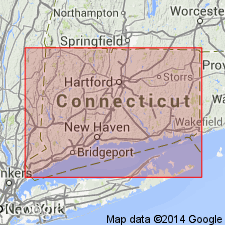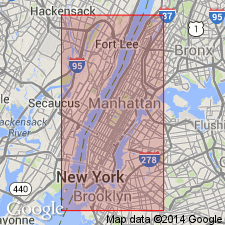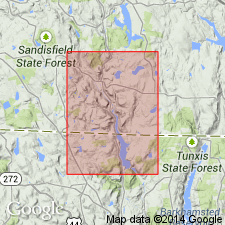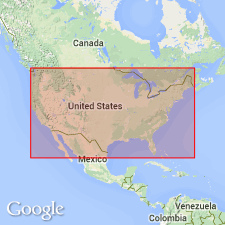
- Usage in publication:
-
- Hartland schist
- Modifications:
-
- Named
- Dominant lithology:
-
- Schist
- AAPG geologic province:
-
- New England province
Summary:
Named Hartland schist for development of Hartland, Hartford Co., CT. Unit is southern continuation of large areas of rock on Hoosac Mountain. Consists of mica schist of definable character, but exhibits great variation in texture, composition, and field appearance. Where least affected by intrusion it is highly fissile. Ranges in color from clear metallic muscovite to black biotite mixed with graphite. Sericite and chlorite often replace biotite. Age is considered Early Cambrian.
Source: GNU records (USGS DDS-6; Reston GNULEX).

- Usage in publication:
-
- Hartland Formation*
- Modifications:
-
- Age modified
- AAPG geologic province:
-
- New England province
Summary:
In Bronx Co., NY, the Hartland Formation is divided into two units. The western unit is further divided into five subunits. Subunit 1 is quartz-biotite-muscovite schist. Subunit 2 is gray, fine-grained quartz-muscovite-biotite schist. Subunit 3 is white to pinkish-white, gneissic granite. Subunit 4 is a dark greenish-black amphibolite. Subunit 5 is gray, unevenly foliated gneissic schist. The eastern unit of the allochthonous Hartland Formation is its Pelham Bay Member. The Hartland and related Ravenswood Granodiorite, east of Cameron's Line, overlie Manhattan Schist Member C of Early and Middle Cambrian age. The age of the Hartland, Pelham Bay, and Ravenswood ranges from Middle Cambrian to Middle Ordovician (fig. 2).
Source: GNU records (USGS DDS-6; Reston GNULEX).

- Usage in publication:
-
- Hartland Formation*
- Modifications:
-
- Age modified
- AAPG geologic province:
-
- New England province
Summary:
In New York City, Cameron's Line, a tectonic boundary which shows evidence of extreme compression and thrust faulting, separates the Manhattan Prong, with its Middle Proterozoic Fordham Gneiss overlain by Cambrian and Ordovician allochthonous units on the west, from the allochthonous eugeoclinal Hartland Formation and Ravenswood Granodiorite on the east. The Hartland is mapped in the east Bronx and Queens; the Ravenswood in is Queens, Kings, and lower east Manhattan. All three of these were previously mapped as Brooklyn Gneiss or Brooklyn Injection Gneiss, which should be abandoned. The age of the Hartland and Ravenswood is Cambrian and Ordovician, based on correlation with rocks of southwestern CT, their relative positions and lithologic similarities. Isotope data on the Ravenswood gives an early Paleozoic age, probably Early Ordovician.
Source: GNU records (USGS DDS-6; Reston GNULEX).

- Usage in publication:
-
- Hartland Group
- Modifications:
-
- Overview
- AAPG geologic province:
-
- New England province
Summary:
Hartland Group in western CT according to this report includes the Litchfield Schist and the Mt. Tom Amphibolite in the Bantam Lake thrust sheet, and the Mt. Prospect Formation [Prospect Formation], the Mt. Rat Schist, and the Bee Brook Formation in the Cameron's Line thrust sheet. [Mount Rat and Bee Brook are not found in the Geologic Names Unit files, though author does not indicate that they are new.] Hartland is intruded by the Mt. Prospect Igneous Complex in this region.
Source: GNU records (USGS DDS-6; Reston GNULEX).

- Usage in publication:
-
- Hartland Formation*
- Modifications:
-
- Overview
- AAPG geologic province:
-
- New England province
Summary:
Serpentinized ultramafic rock follows strike of Cambrian and (or) Ordovician Rowe Schist (Rodgers, 1985; mapped as Hartland Formation by Martin, 1970, and as Slashers Ledges Formation by Stanley, 1964).
Source: GNU records (USGS DDS-6; Reston GNULEX).
For more information, please contact Nancy Stamm, Geologic Names Committee Secretary.
Asterisk (*) indicates published by U.S. Geological Survey authors.
"No current usage" (†) implies that a name has been abandoned or has fallen into disuse. Former usage and, if known, replacement name given in parentheses ( ).
Slash (/) indicates name conflicts with nomenclatural guidelines (CSN, 1933; ACSN, 1961, 1970; NACSN, 1983, 2005, 2021). May be explained within brackets ([ ]).

